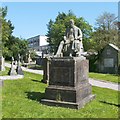Henry Bell is commemorated by other monuments, such as
Image at Dunglass near Bowling, and another obelisk in Helensburgh:
Image
The memorial in the present photograph stands in the kirkyard of
Image, and was erected by fellow engineer Robert Napier, who also provided some of the funds for the building of the church itself (see the listed building report mentioned in the end-note; for more on Napier himself, see
Image).
For other images, see
Image, and another contributor's earlier picture:
Image
The inscriptions around the base are rather worn, but read as follows:
NEAR: "Henry Bell / Born 7th April 1767 / Died 14th Nov 1830 / His spouse / Margaret Young / Died 30th April 1856."
RIGHT: "Underneath / lie the remains of / Henry Bell / and his spouse and true helpmate / Margaret Young."
LEFT: "The / Comet / built for Henry Bell in 1811 / was the first steam vessel in / Europe / which successfully navigated / rivers and open sea."
FAR: "Erected / by / Robert Napier / Engineer and Shipbuilder / Glasgow."
The modern building in the background is a nearby primary school. On the steam vessel Comet, see
Image Some sources give a different month for the date of Bell's death, but it was in November, as indicated above.
Much more information can be found in the book "The Ingenious Mr Bell", by the late Brian D. Osborne, who was a Geograph contributor (see http://www.geograph.org.uk/profile/2117 for his images). Bell's grave, here in Rhu kirkyard, was unmarked for a long time, even though Bell had previously provided a memorial there for Captain Robert Bain (of the above-mentioned Comet); it is located nearby:
Image
The Henry Bell Monument at Dunglass (see above) was erected in 1839, but it was Robert Napier who provided the memorial shown in my photograph: "Napier remedied the lack of a memorial to Bell by erecting a statue in Rhu churchyard in 1853"; nineteen years later, "he again recognised Bell by becoming one of the major contributors to the monument to Bell on the seafront at Helensburgh" [from the book just cited].











